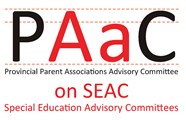PAAC on SEAC members meet regularly and have the unique ability to quickly collect or disseminate information that is relevant to members of Special Education Advisory Committees across Ontario. In the spring of 2014, PAAC on SEAC members developed a survey of SEAC members regarding SEAC effectiveness. The survey questions were similar to previous surveys by PAAC on SEAC. The Tourette Syndrome Foundation of Canada supported the survey by providing SurveyMonkey as a tool for obtaining SEAC responses. (The 2014 and 2009 survey questions and analysis of results are available on the PAAC on SEAC website at www.paac-seac.ca)
The survey link was made available to SEAC members through letters mailed to every SEAC Chair in the province. The survey was open for approximately 6 weeks in May and June 2014. A total of 178 people responded to the survey, an increase of 27% over the 2009 survey. There were responses from SEAC members on a total of 50 different school boards.
From the answers to the questions about school board and association affiliation it would appear that the demographics of the survey respondents are representative of the distribution of SEAC members. Survey respondents were from a cross section of school boards in the province, large and small boards, urban and rural, catholic and public and four French boards. There also appears to be proportional representation from the provincial parent associations reflecting the relative size of each association’s number of SEAC members. It would appear that slightly more than half were in their first SEAC term and almost 20% had been on SEAC for more than 10 years.
PAAC on SEAC members believe the responses to the survey to be consistent with the feedback from the 2015 SEAC Provincial Conference. The key issues and concerns identified by SEAC representatives are in the areas of: SEAC participation, training, parent engagement, and recruitment. For more details on the issues see the Executive summary of The SEAC 2014 Survey of SEAC Effectiveness on the PAAC on SEAC Website at www.paac-seac.ca and the feedback from the SEAC Provincial Conference on the EduGAINS website at http://www.edugains.ca/newsite/SpecialEducation/seac.html.
In developing this handbook the key issues have been organized into five topics:
- Membership
- SEAC Roles and Responsibilities
- Information and Knowledge Transfer
- SEAC Meeting Processes
- Provincial and Local Parent Associations
For each topic in the handbook, PAAC on SEAC has provided recommendations and a list of effective practices. A statement, PAAC on SEAC recommends that the following action …., is highlighted through bolding and indicates that members of PAAC on SEAC strongly encourage the action or activity.
The effective practices lists have been generated from the experience of provincial parent associations and SEAC members across the province. Each list includes examples of potential activities for consideration. Each SEAC member, or each school board SEAC, is encouraged to look at the list of examples and consider whether they could improve SEAC effectiveness by adopting the practice.
The handbook has been deliberately written in a generic style and specific school board or parent association examples have not been identified.
The information, recommendations and effective practices included in this handbook belong to the members of the Provincial Parent Associations Advisory Committee on Special Education Advisory Committees (PAAC on SEAC) and do not necessarily reflect those of the Ministry of Education.
